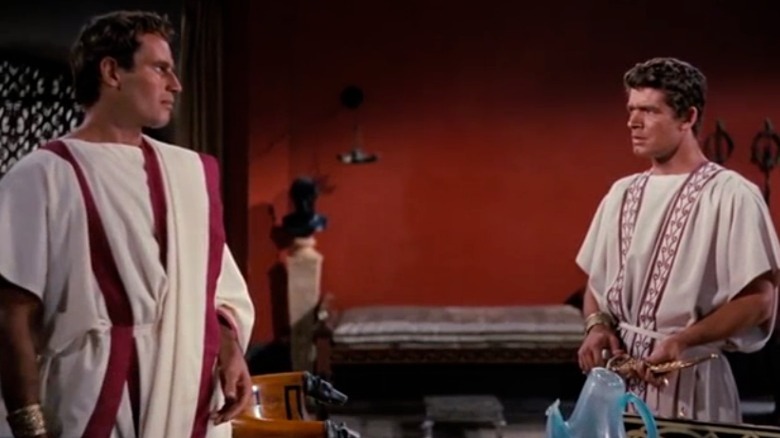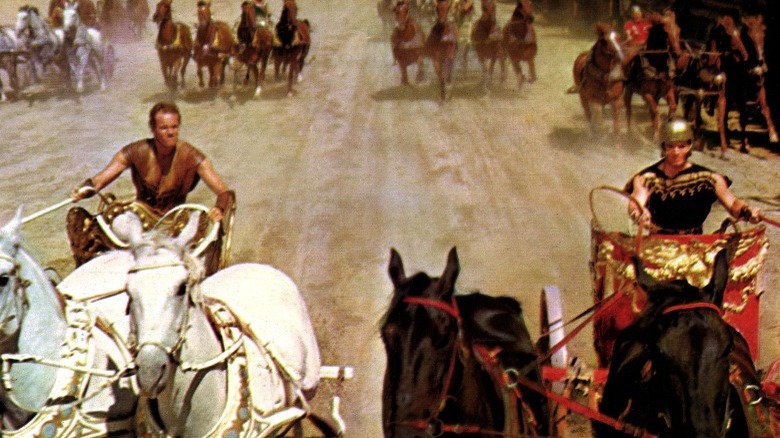Ben-Hur Ending Explained: The Human Side Of The Biblical Epic
While the bubble would eventually burst in the early '60s, the biblical epic was a favorite genre in '50s Hollywood. Producers and audiences sought bigger and more lavish widescreen productions every year. The religious, ancient-world backdrop of these movies let them film in "exotic" European or Middle Eastern locales and employ armies of extras. Marketed to churchgoing audiences and the mainstream alike, they were expensive, action-packed, and romantic. When it came to walking this line, one of the best movies in the genre was William Wyler's 1959 historical drama "Ben-Hur."
The second adaptation of Lew Wallace's novel "Ben-Hur: A Tale of the Christ," the movie features a huge star-studded cast and the genre's typical beautiful location photography. Like most epics, the sense of scope owes a lot to the runtime, which runs for nearly four hours, and its $15 million budget made it the most expensive film made to that point. Whether you're watching an intimate scene between friends or the parade that precedes the climactic chariot race, the movie's size inspires awe.
Wyler, a perfectionist director who mastered the costume drama with movies like "The Heiress," was a natural choice to direct. Not only was his artistry capable of connecting to commercial demand, he knew how to get good performances and create characterization, the true bedrock of an epic's success.
The Jewish Prince
Judah Ben-Hur (Charlton Heston), a Jewish prince living in Jerusalem, reunites with his childhood friend Messala (Stephen Boyd), who has spent years campaigning for the Roman Empire. He is set to be second-in-command to the new Roman governor of Judea, and while his allies complain of the Jewish rebellion, Messala expects his friend's loyalty. Judah feels betrayed as Roman soldiers begin to line his familiar streets and his oldest friend wants information on the rebels.
Feeling the sting of rejection from his love Esther (Haya Hayareet) on top of that, Judah retreats to the comfort of his mother and sister. But Messala seizes on an opportunity — he blames Judah for an incident that befalls the new Roman governor of Judea and imprisons his family. Judah is enslaved, shackled to a Roman detachment. He's given water by a mysterious stranger as he collapses from thirst.
Years pass, and he ends up working the ships of Consul Quintus Arrius (Jack Hawkins). After Judah saves his life during a disastrous naval battle, Arrius adopts him and trains him in the sport of charioting.
The story of vengeance, sought by Judah against Messala, is rich in human drama (and gay undertones, courtesy of script doctor Gore Vidal). But Wyler struggled with his lead actor. Handsome but dull, Heston was best-known for playing another Jewish character in another biblical epic: Moses in 1956's "The Ten Commandments." Regarding the supposed flaws in his performance, the "Ben-Hur" director, nicknamed "90-take Wyler," only told Heston to "be better."
The Chariot Race
Much of the movie's second half concerns a particular chariot race, with Judah persuaded to compete by the sheik Ilderim (Hugh Griffith in unforgivable brownface). He refuses, even after learning that Messala will be competing as well. Returning to Jerusalem, Judah reunites with Esther. She informs him that his mother and sister are dead, but the truth is that they contracted leprosy in prison and now hide in shame. His lust for vengeance newly reawakened, he decides to compete in the race, which became a key cornerstone of film history.
While the original draft of the movie had little of the final chariot race, it encompassed 38 pages of script by the time filming was to commence. Extensive work was done to build the scene into something truly special, as the two former friends confront each other.
Underneath the sportsmanship, the race is all violence: blades on the wheels, bodies dragged under racing hooves, the stunts orchestrated by guest directors Andrew Marton and Yakima Canutt. As Messala attacks Judah during the race, Stephen Boyd brings all of the spurned lover rage that colored his work in the first half of the movie back to the fore. The race is beautifully executed and still thrilling even now, often imitated but never exceeded (in either the pod race of "The Phantom Menace" or Timur Bekmambetov's 2016 remake).
A Tale of the Christ
Messala suffers injuries during the race, close to death in its aftermath. He tells his former friend that his mother and sister are not dead, and can be found in the Valley of the Lepers. He can only howl, in his dying words, that the race "is not over."
Judah and Esther go to the Valley and find his family sick, covering their wounds in robes and cloth. The group ends up discovering Jesus on his way to crucifixion, where Judah recognizes him as the mysterious stranger who gave him water during his days as a slave. He returns the favor. On Jesus' crucifixion, Judah's mother and sister are cured of their leprosy, the ailment erased in a miracle.
It's easy to dismiss the biblical epic, a genre that typically told epic but old-fashioned stories from a stately distance. But "Ben-Hur," a "Tale of the Christ," stands above the pack with its humanity, using the larger religious story for the smaller tragedy of Judah's fall from nobility, his family's time in exile, and his complex relationship with Messala. For the movie's portrayal of divinity, William Wyler never filmed Jesus' face. But this decision also highlights the lack of divinity in the movie's protagonist, whom Charlton Heston, called "the big cornpone" by the movie's crew according to writer Gore Vidal, plays with gentle determination. His world is brutal, and only the chance of miracles saves him.



